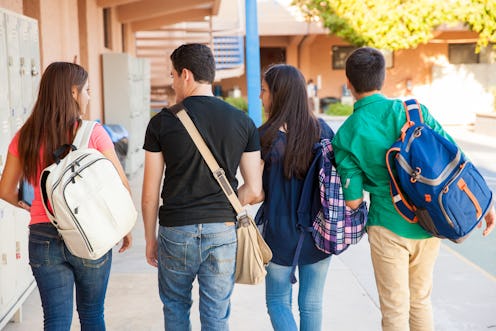
In an effort to better understand current trends in sexual behaviors among high school students. Researchers at the Guttmacher Institute compiled data obtained over the last five years by the Centers for Disease Control and Prevention (CDC) in a report. They studied responses to the CDC's 2013, 2015, and 2017 Youth Risk Behavior Survey and found that while some sexual health issues facing teens are better controlled than ever, others have cropped up to replace them, leaving high schoolers especially vulnerable to things like STIs and sexual violence.
Access to sexual health resources and comprehensive sex education is still the best tool for preventing unfavorable outcomes, researchers say. And arming teens with this information does more than just come in handy in the heat of the moment. Having time to consider sexual health practices and weigh their options before they're sexually active actually gives teens better agency over their sex lives in general. In other words, it isn't just about structuring education around preventing "bad things" from happening; it's about presenting students with all the possibilities, and trusting them to choose what they want to happen.
Notably, the CDC's Youth Risk Behavior Survey only polled teens who were enrolled in high school, so adolescents who had dropped out went unrepresented in the data. But here's what report authors Elizabeth Witwer, Rachel K. Jones, and Laura D. Lindberg found when breaking down the survey responses.
1
There's An Overall Decrease In The Proportion Of Students Who've Had Sexual Intercourse
Sexual intercourse among high school students has been in steady decline since 1991. But in 2017, just 40 percent of high schoolers reported having had intercourse, which is the lowest rate since 1991, when the survey began. The decline was greatest among black students.
2
Older Students Are More Likely To Have Sex Than Younger Students
No surprise here, but seniors were more likely to be having sex than freshman — 57 percent compared with 20 percent. Each year, about one in five teens will newly start having sex.
3
LGB Girls Are More Likely To Be Sexually Active Than Straight Girls
Eighty-five percent of the students surveyed identified as heterosexual. But among girls who identified as gay, lesbian, or bisexual, 50 percent of them had had sexual intercourse, compared to just 36 percent of their straight counterparts.
4
Younger Students Are Less Likely To Use Contraceptives
Overall, students reported using contraceptives at pretty high rates. Ninety percent of boys and 84 percent of girls reported that either they or their partner had used a contraceptive the last time they had sex. But one in five ninth graders reported not using contraceptives, while only one in 10 juniors and seniors graders weren't using them. This makes sense given the stigma, shame, and access issues younger teens face when becoming sexually active.
5
More Students Are Using IUDs, But Fewer Are Using Condoms
IUD use doubled in teen girls from 2013 to 2017. It, along with other prescription methods like birth control implants, injectables, patches, rings or pills were used by 35 percent of teen girls in 2017. But that number spiked most significantly amongst senior girls. They saw a rise in prescription birth control use from 36 to 45 percent between 2015 and 2017. Unfortunately, condom use has slipped by several points across all demographics. And following that logic...
6
Pregnancy Rates Are Falling, But STI Rates Are On The Rise
The pregnancy rate among teens has dropped 38 percent from 2006 to 2013, but STI rates — the study calls out chlamydia and syphilis specifically — are newly on the rise among young people. With more reliable long-term birth control methods slowly becoming more accessible to teens, it appears that diligence about using condoms as well to prevent against STIs has been lacking.
7
LGB Students Are More Than Twice As Likely To Experience Sexual Violence
Girls were more than three times as likely to experience sexual violence, such as forced kissing, touching, or sexual intercourse, than boys. But 22 percent of LGB-identified students reported experiencing sexual violence as compared with only eight percent of their straight counterparts.
As of December 2017, only 24 states mandate sex education. And if it is taught, 27 states require that abstinence be stressed. But as the report shows, and researchers state, there's certainly a need to provide students with more comprehensive sex ed and access to sexual health services.